Four delicious cult Malaysian recipes from the island of Penang
Updated , first published
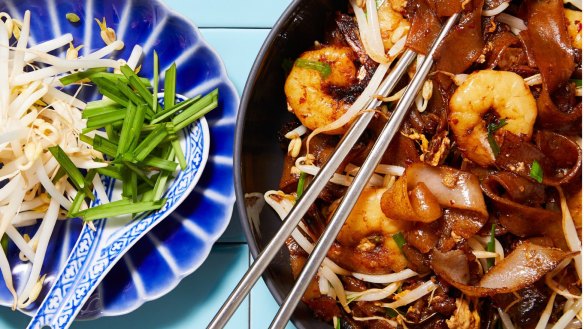
The Malay Peninsula has welcomed ships from around the world for centuries, resulting in a rich food culture that combines influences from the Middle East, India, Europe, China and Indonesia.
Nowhere is this more true than in the north-west state of Penang, where intoxicating dishes rich in cumin, lemongrass, makrut leaves, cardamom, star anise, coriander and fenugreek can be found in homes, eateries and street stalls.
In their new book, Penang Local, Melbourne-based collaborative duo Aim Aris and Ahmad Salim of casual pop-up dining brand Scintilla have collected 70 recipes that define the region.
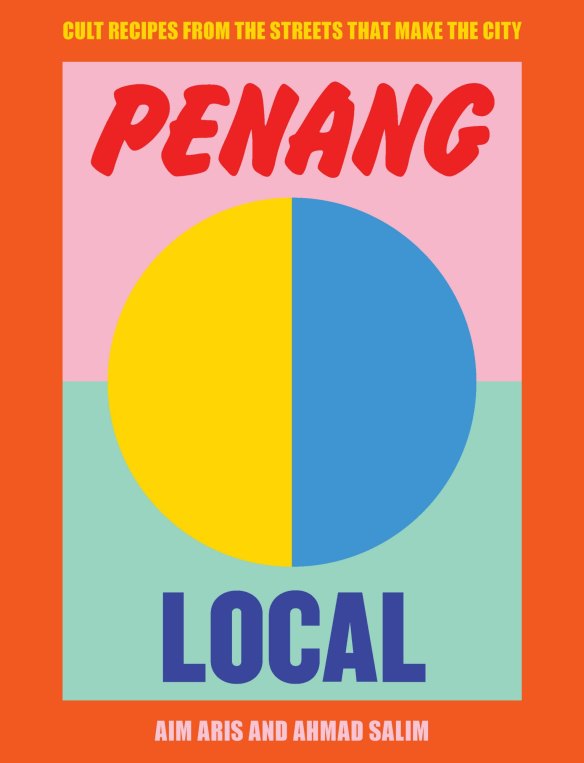
From charry stir-fries to fragrant rice plates, these four specialty Malaysian dishes can be cooked at home using widely available ingredients.
Char kwai teow (Stir-fried flat rice noodles)
Penang is very well known for its char kwai teow and this dish is at the top of everyone's list when they visit. Apart from anything else, it's always so interesting to watch the hawkers prepare it. Some use charcoal fire and others have a gas stove, but every hawker knows that the secret to a good char kwai teow is to work fast and cook it in a cast-iron wok over very high heat to give it its distinctive charred flavour or "wok hei" (breath of the wok).
INGREDIENTS
- 500g fresh kwai teow (flat rice noodles)
- 80ml (⅓ cup) vegetable oil
- 4 garlic cloves, minced
- 1 tbsp Malaysian dried chilli paste
- 1 lap cheong (Chinese sausage), sliced diagonally
- 8-10 large banana prawns, peeled and deveined, tails intact
- 2 tbsp light soy sauce
- 2 tbsp dark soy sauce
- 1 tbsp oyster sauce
- 2 eggs (preferably duck eggs)
- 180g (2 cups) bean sprouts, washed and drained
- 2 small handfuls of garlic chives, cut into 2.5cm in lengths
METHOD
- Prepare the rice noodles according to the packet instructions. Loosen the strands so they do not clump together and break when you stir-fry them. Set aside. Make sure you have all your ingredients prepped and within reach before you start cooking as the process will be super quick.
- Heat a wok over high heat until it becomes a bit smoky. Add the oil, immediately followed by the garlic and chilli paste and give it a quick stir. Add the lap cheong and stir briefly, then add the prawns and stir with a spatula for 1 minute or just until they turn pink. We do not want them fully cooked yet.
- Push the ingredients to the side of the wok and add the rice noodles followed by the soy sauces and the oyster sauce. Stir-fry until some of the noodles get a little charred – this will take less than 1 minute.
- Push the ingredients to the side of the wok again and crack in the eggs. Let them cook undisturbed for about 20 seconds, then break the yolks and quickly mix everything together. Add the bean sprouts and garlic chives and stir for 30-40 seconds. Serve immediately.
Serves 2, generously
Nasi lemak (Coconut rice)
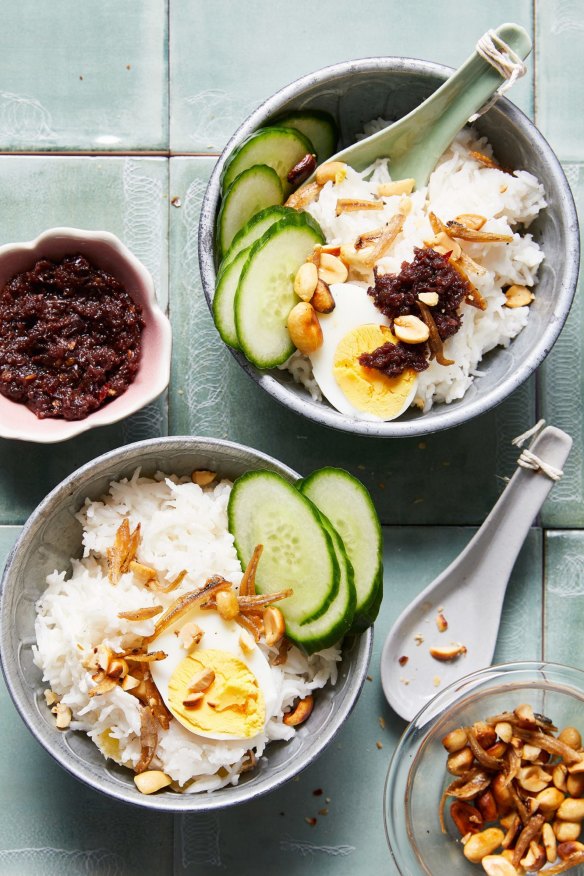
Nasi lemak is a fragrant rice dish cooked in coconut milk and pandan leaves. A basic nasi lemak usually comes with sambal, hard-boiled egg, sliced cucumbers, fried peanuts and fried dried anchovies, but these days just about anything goes, such as chicken rendang, cockles rendang or prawn sambal. Typically, street hawkers would wrap the nasi lemak in a banana leaf to make the rice more fragrant – some still do this, but many opt for brown paper as a more convenient and economical wrapping.
If you go to the many street stalls, kopitiams (coffee shops) or food courts around Penang you can easily buy the mini version of nasi lemak very cheaply, offering a quick breakfast fix for locals and tourists alike.
INGREDIENTS
- 400g (2 cups) basmati or long-grain rice
- 250ml (1 cup) coconut cream
- 5cm piece ginger, sliced
- 1 tsp salt
- 2 pandan leaves, knotted (substitute for pandan leaf extract/essence if leaves are unavailable)
Sambal
- 2 large red onions, sliced
- 3 garlic cloves, sliced
- 15 dried chillies, soaked in water for 15 minutes
- 30g (1 cup) dried anchovies
- 2.5cm piece toasted belacan (shrimp paste)
- 200ml vegetable oil
- 2 tbsp sugar, plus extra if needed
- 1 tbsp tamarind paste
- salt
To serve
- hard-boiled eggs, halved, or fried eggs, sunny side up
- sliced cucumbers
- fried peanuts
- fried dried anchovies
METHOD
- To make the sambal, place the red onion, garlic, drained dried chillies, dried anchovies, belacan and 100ml of the oil in a food processor or blender and process to form a paste.
- Pour the remaining oil into a frying pan and heat over medium heat. Add the chilli paste and cook, stirring regularly, for 4-5 minutes until it turns a darker shade of red and the oil has separated.
- Add the sugar and cook for another minute to let it caramelise with the sambal. Add the tamarind paste and 125ml (½ cup) water and cook, stirring, for 3 minutes or until the sambal has thickened slightly. Season to taste with salt and extra sugar if needed. Keep in mind that the sambal should be a good balance of sweet, spicy and sour flavours.
- Wash the rice until the water runs clear, then tip it into a rice cooker. Add the coconut cream and 500ml (2 cups) water and stir in the ginger, salt and pandan leaves.
- Leave to soak for 5-10 minutes, then switch the rice cooker on and cook the rice according to the manufacturer's instructions.
- Lightly fluff up the cooked rice with a fork or a wooden spoon. Serve immediately with the sambal, egg, cucumber, peanuts and dried anchovies.
Serves 4
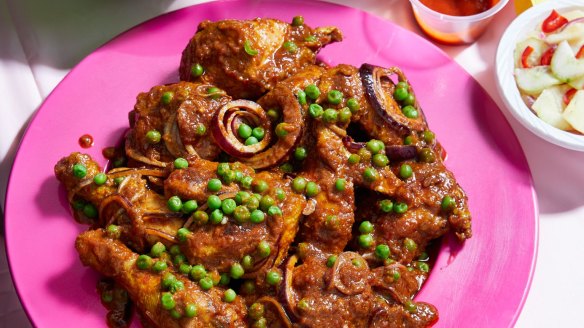
Ayam masak merah (Chicken in sweet and spicy tomato sauce)
This classic dish is very popular with the locals, especially in Penang, Kedah and Perlis in the north of Malaysia. The sauce is packed with well-balanced flavours.
INGREDIENTS
- 125ml (½ cup) vegetable oil
- 1 cinnamon stick
- 1 star anise
- 2 cardamom pods
- 2 tbsp sugar, or to taste
- 125ml (½ cup) Malaysian or other hot chilli sauce
- 2 tbsp tomato paste
- 125ml (½ cup) coconut milk
- ½ tsp tamarind paste
- 100g (¾ cup) frozen baby peas
- 1 large red onion, sliced into rings
- salt
Turmeric chicken
- 1 x 1.8kg chicken, cut into 8 pieces
- 2 tbsp ground turmeric
- 2 tsp salt, or to taste
- vegetable oil, for pan-frying
Chilli paste
- 1 large red onion, roughly chopped
- 5 garlic cloves
- 2 tbsp Malaysian chilli paste
- 3 tbsp vegetable oil
METHOD
- To make the turmeric chicken, place the chicken in a glass or ceramic bowl, add the turmeric and salt and massage it into the skin. Leave to marinate for at least 15 minutes.
- Heat the oil in a wok or frying pan over medium heat until hot and a little smoky. Working in batches, gently drop the marinated chicken into the oil and cook for 5 minutes. You want it to be half-cooked and nicely golden. Remove and drain on a plate lined with paper towel. Leave half the oil in the pan.
- To make the chilli paste, place all the ingredients in a blender or a food processor and blend to a smooth paste.
- Heat the reserved oil from the chicken over medium heat. Add the chilli paste and cook, stirring, for 2-3 minutes until aromatic and darker in colour. Add the cinnamon stick, star anise and cardamom pods and stir well. Add the sugar, chilli sauce and tomato paste and stir for another 10-15 seconds. Add the half-cooked chicken and mix everything together, then cook for 2-4 minutes until the chicken is cooked through. Stir in the coconut milk, tamarind paste, peas and sliced onion, and season to taste with salt.
Serves 4
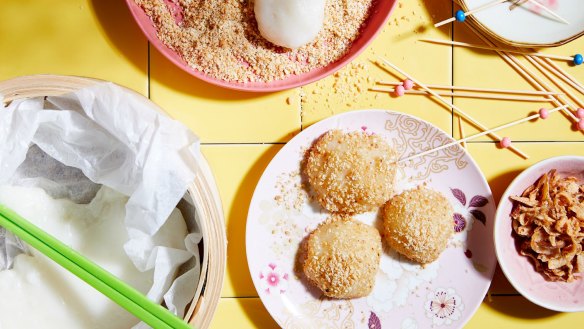
Peanut mochi
Muah chee is a sweet-savoury snack made with glutinous rice flour that is very similar to Japanese mochi (rice cakes). In Penang, it is usually served with fried shallots for texture and added depth of flavour.
INGREDIENTS
- 1 tbsp cornflour
- 120g glutinous rice flour
- 1 tbsp vegetable oil
- ¼ tsp salt
- crispy fried shallots, to serve (optional)
Roasted peanut-sesame mix
- 25g ground dry-roasted peanuts
- 25g sesame seeds, lightly toasted
- 25g caster sugar
METHOD
- To make the roasted peanut-sesame mix, combine all the ingredients and store in an airtight container until needed. It will keep for up to 2 weeks.
- Place the cornflour, rice flour, oil, salt and 200ml water in a bowl and mix well.
- Pour the dough into a lined steamer basket and steam for about 15 minutes or until a toothpick poked into the centre comes out clean. Transfer to a bowl.
- Using a pair of chopsticks or a fork, stir the muah chee dough until it is springy in texture. Cut it into bite-sized pieces and toss in the roasted peanut-sesame mix to coat.
- If you'd like to enhance the sweet-savoury flavour, sprinkle with fried shallots before serving.
Serves 4
This is an edited extract from Penang Local by Aim Aris and Ahmad Salim, published by Smith Street Books, RRP $39.99. Photography by Georgia Gold. Buy now
Appears in these collections
From our partners
Original URL: https://www.brisbanetimes.com.au/goodfood/four-delicious-cult-malaysian-recipes-from-the-island-of-penang-20210527-h1w3yc.html